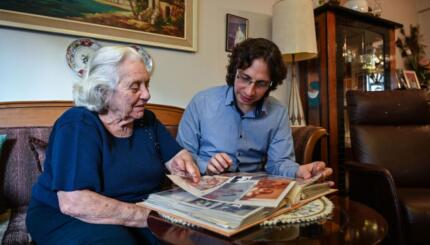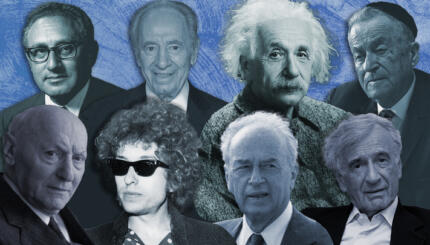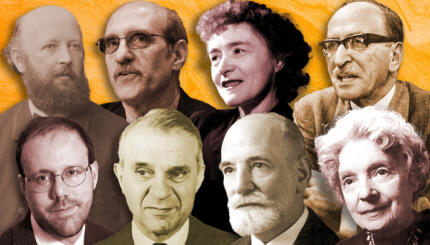Excerpted with permission of the author from Hadassah Magazine.
“The Jewish film festival is my favorite Jewish holiday,” wrote a respondent on an audience questionnaire at a recent San Francisco Jewish Film Festival.
With festivals drawing nonaffiliated Jews as well as regular synagogue-goers, that’s not a surprising sentiment. And with the burgeoning number of festivals, it’s a holiday millions are observing.
Big Cities, Small Cities
If you live in California, you don’t have to go farther than the beautiful single-screen Castro Theatre during festival weeks to get first-hand evidence of the San Francisco Jewish Film Festival’s popularity: The line includes old and young, gay and straight, observant and nonobservant as well as non-Jewish. It’s where you meet your old friends and exchange opinions about last night’s show. People tend to go to more than one film and stay for the post-film question and answer session with the filmmaker–Jews, after all, are verbal people.
With your help, My Jewish Learning can provide endless opportunities for learning, connection and discovery.
Many screenings in the 1,400-seat Castro Theatre and in other venues sell out each year. “I had no doubt that there was going to be an audience,” reminisces festival founder and former director Deborah Kaufman about the event’s early days. “I did not know how big an audience it was going to be.”
 Jewish film festivals, many only a few years old, are held not only in such obvious places as New York, Los Angeles, and San Francisco–at 23 years, the oldest and still the biggest–but also in Omaha, Fresno, and northeast Pennsylvania. And that’s just in the United States where, according to a 2002 study by the Jewish Outreach Institute, there are some 60 Jewish film festivals. Another half dozen are held in Canada and some two dozen in foreign cities, including Brighton, England; São Paolo, Brazil; La Paz, Bolivia; and Hong Kong.
Jewish film festivals, many only a few years old, are held not only in such obvious places as New York, Los Angeles, and San Francisco–at 23 years, the oldest and still the biggest–but also in Omaha, Fresno, and northeast Pennsylvania. And that’s just in the United States where, according to a 2002 study by the Jewish Outreach Institute, there are some 60 Jewish film festivals. Another half dozen are held in Canada and some two dozen in foreign cities, including Brighton, England; São Paolo, Brazil; La Paz, Bolivia; and Hong Kong.
“It is a remarkable network that has developed–big, small, and medium-sized festivals–all over the place,” says filmmaker Bonnie Burt. “They are cropping up like little mushrooms.” Her recent documentaries A Home on the Range, about early 20th-century Jewish chicken farmers in Petaluma, Calif., and Song of a Jewish Cowboy, about a contemporary Jewish cowboy living in California, have been festival hits.
Film Festivals Abound
The growth of Jewish film festivals coincides with the popularity of film festivals in general. The San Francisco Bay Area, for instance, hosts at least three international festivals, not to mention special-themed events–Asian-American, gay and lesbian, Latino, Arab, silent, and many others. Since the decline in import and even production of foreign films festivals have helped fill audiences’ desire for something other than standard Hollywood fare. Jewish festivals, mostly concentrating on independent films, both features and documentaries, and mostly in foreign languages, fit snugly into this pattern.
The kinds of films shown depend in part on a festival’s venue and its sponsors. Some are held in Jewish community centers, museums, or synagogues. More–at least half, according to Greg Laemmle of Los Angeles’s Laemmle Theater chain–are held in theaters. Films for the Brooklyn Jewish Film Festival screen at the Brooklyn Academy of Music. The Las Vegas Celebration of Jewish Film, just two years old, holds its screenings in a casino (where else?). San Francisco’s festival screens at three Bay Area theaters and on the University of California campus.
The locale is frequently tied to the festival’s funding. Since only about one-half to one-third of an event’s funds come from ticket sales, money needs to be raised from other sources. Most Jewish festivals get support from Jewish organizations. Almost all get additional funding from government grants (mostly local, regional or state), arts organizations, foundations and corporations. However, public funding involves a good deal of politics and formidable amounts of paperwork–and, in the current economic climate, it’s becoming ever harder to obtain. To get grants today, says Felicia Shaw of the San Diego Commission for Arts and Culture, “you have to be fearless.”
Controversial Fare
Only four North American festivals have no institutional affiliation with the Jewish community: San Francisco, Boston, Toronto, and Brooklyn. Therefore, these festivals are free to show films that might offend some theater-goers.
In 2002, for example, San Francisco programmed seven films (out of 51) relating to Israelis and Palestinians, and attendance was high. Janis Plotkin, another former director of the San Francisco Jewish Film Festival, admits that seven might have been a few too many. But, she points out, ignoring “the situation” is like having an elephant in a roomful of Jews–an elephant that nobody wants to discuss.
Still, Plotkin believes controversial films need to be shown; in fact, among the founding principles of the San Francisco festival was the idea of using art as a catalyst for discussion. “[Our] festival has been accused of having a liberal agenda. In fact, we’re inclusive–we’re inclusive of the moderate position, and we’ve been criticized for that [too],” she says.
Festivals catering to a more conservative audience, those in small towns or with close ties to synagogues or local Jewish community centers, stick to less controversial fare. And groups with less funding program older films. In 2002 and 2003, for instance, the documentary From Swastika to Jim Crow (1999, by Lori Cheatle, Steven Fischler, Joel Sucher and Martin D. Toub) were shown in several festivals; so has Matej Miná’s Czech Holocaust feature, All My Loved Ones (1999).
Boon or Mixed Blessing?
For filmmakers, Jewish film festivals can be a boon or a mixed blessing, depending on their expectations. “What is nice about the Jewish film festivals, in addition to creating a community,” says director Valerie Lapin Ganley, “is that they offer a venue for us to celebrate what being Jewish is all about–to rejoice in the best things about Jewish culture, history, accomplishments and identity and to critically address the tough issues and challenges that face us as a people.”
But the festivals aren’t only for Jewish people,” she continues. “They are a place where others can come and learn about us, and because Jewish films so often explore the diversity of Jewish identity we can all learn about other cultures.”
Ganley’s Shalom Ireland, a documentary about the Diaspora Jews of the Emerald Isle, had its United States premiere this year in San Francisco. Filmmaking, she points out, is a lonely process: “It isn’t until you are able to show the film in a public forum…that you can see how your project may enrich the lives of others, by offering them something that is entertaining and that they can learn from.”
Pearl Gluck, whose documentary, Divan, about her search for a historic couch on which nineteenth-century rebbes slept, was screened at this year’s San Francisco festival, says that Jewish festivals are “…notorious for getting the audience out there and getting support for a film.” She quotes the distributors for her film as saying, “‘Don’t you dare turn any Jewish festivals down, because they are the best.'”
However, Los Angeles-based Amir Bar-Lev, whose documentary Fighter went into limited general release after making the festival circuit, says that it’s important to show your films in the right order. Fighter, about boxer Jan Weiner’s and novelist Arnost Lustig’s visit to their European pasts opened at the Los Angeles International Film Festival and then went on to other non-Jewish venues before starting on the Jewish circuit. “If you do the Jewish festivals first, the regular ones don’t want you,” says Bar-Lev.
David Magidson, director of Detroit’s Lenore Marwil Jewish Film Festival, agrees that filmmakers might have problems if they rely exclusively on Jewish festivals. “There’s a food chain of feature films,” he says. “If it’s any good, the [Jewish] festivals don’t get it.” The aim of distributors is to get their films distributed commercially, and they don’t want festivals to have first crack at a film in fear that they’ll be “using up” the audience.
However, the San Jose (California) Jewish Film Festival showed Roman Polanski’s The Pianist a month before it opened commercially, and the screening helped build the film’s market. Some other films that have appeared at Jewish festivals and then gone on to commercial distribution are Promises, Trembling Before G-d and Aviva Kempner’s The Life and Times of Hank Greenberg.
“Pay-Per-View” Judaism
But getting an advance peek at a movie before it goes into general distribution–and possibly wins Academy Awards, as The Pianist did this year–is only a small part of the reason why people attend Jewish film festivals. A recent study conducted with the assistance of the Stanford University Jewish studies program showed that people believe that going to a Jewish film festival was a valid expression of their Jewish identity–however they define it.
Richard Siegel, executive director of the National Foundation for Jewish Culture, asks, “Are we experiencing a different way of being Jewish in America?” Being Jewish, he says, may mean a more selective, “pay-per-view” Judaism, in which people may go to services once a year, may read novels by Jewish writers and may go to Jewish films festivals.
“From the point of view of the Jewish community, it’s a revolutionary idea,” says Plotkin. “You can be Jewish without belonging to a synagogue and without being married to someone Jewish.”


